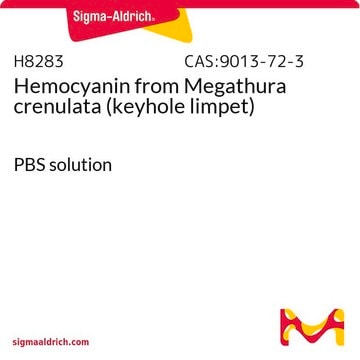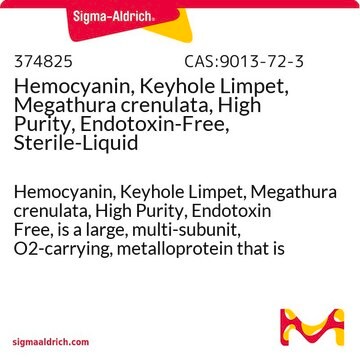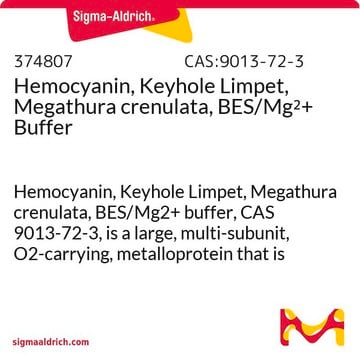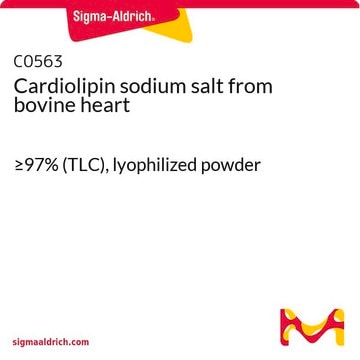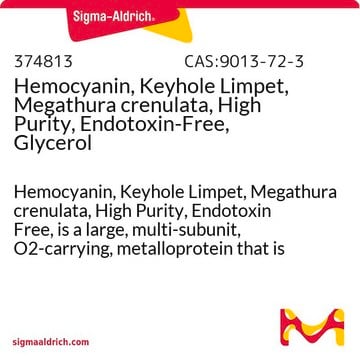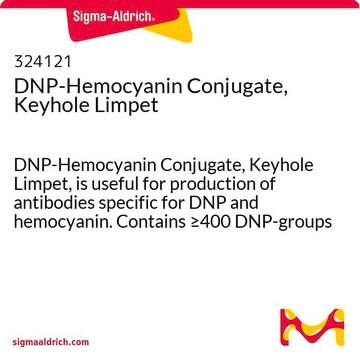374817
Hemocyanin, Keyhole Limpet, Megathura crenulata, Glycerol
Hemocyanin, Keyhole Limpet, Megathura crenulata, Glycerol, is a large, multi-subunit, oxygen-carrying, metalloprotein that is used as a carrier protein in the production of antibodies.
Synonym(s):
Hemocyanin, Keyhole Limpet, Megathura crenulata, Glycerol, KLH
Sign Into View Organizational & Contract Pricing
All Photos(1)
About This Item
Recommended Products
Quality Level
assay
>90% (size exclusion chromatography)
form
liquid
manufacturer/tradename
Calbiochem®
storage condition
OK to freeze
color
clear blue-gray
shipped in
ambient
storage temp.
2-8°C
General description
Carrier protein that has many available primary amines to facilitate protein conjugation. Used to immunize animals to elicit antibodies to small molecules (haptens) by covalent conjugation. Protein: ≥10 mg/ml. Sold on the basis of protein content.
Packaging
Please refer to vial label for lot-specific concentration.
Warning
Toxicity: Standard Handling (A)
Physical form
In 10 mM MgSO₄, 5 mM BES, 50% glycerol, 0.9% sodium chloride, pH 6.5.
Preparation Note
Further dilute with PBS or physiological saline. Material can be dialyzed to remove the glycerol or used as is for conjugation with glutaraldehyde, carbodiimide, or mixed anhydrides.KLH is an extremely large protein complex that has a tendency to aggregate and precipitate from solutions. Use a buffer when diluting KLH and maintain the magnesium concentration at ≥10 mM. Store KLH solutions at 4°C. DO NOT freeze, vortex or agitate to dissolve KLH. Freezing or agitating KLH will cause protein aggregation and precipitation.
Other Notes
Hayashi, K., et al. 1992. Virchows Archiv. B Cell Pathol.63, 37.
Shuler, K.R., et al. 1992. J. Immunol. Methods156, 137.
Shuler, K.R., et al. 1992. J. Immunol. Methods156, 137.
Legal Information
CALBIOCHEM is a registered trademark of Merck KGaA, Darmstadt, Germany
Storage Class
10 - Combustible liquids
wgk_germany
WGK 2
Certificates of Analysis (COA)
Search for Certificates of Analysis (COA) by entering the products Lot/Batch Number. Lot and Batch Numbers can be found on a product’s label following the words ‘Lot’ or ‘Batch’.
Already Own This Product?
Find documentation for the products that you have recently purchased in the Document Library.
Our team of scientists has experience in all areas of research including Life Science, Material Science, Chemical Synthesis, Chromatography, Analytical and many others.
Contact Technical Service
